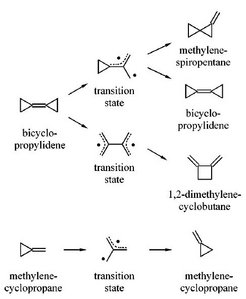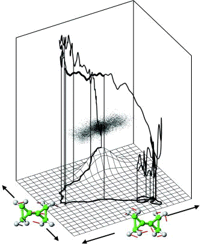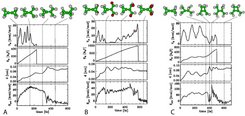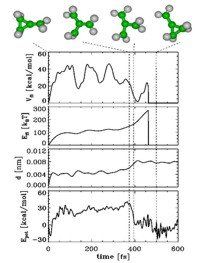Predicting Unimolecular Chemical Reactions: Chemical Flooding

Collaborator: Armin de Meijere (Department of Organic Chemistry, Göttingen University)
The calculation of reaction pathways, energy barriers and reaction rates for chemical reactions of small molecules is a routine task in todays theoretical quantum chemistry. Established methods exist for tasks like (a) minimization of educt states, (b) exploring potential energy hypersurfaces, (c) detecting transition and product states, (d) finding reaction pathways connecting the educt, transition and product state, and (e) calculating the reaction rates by associated quantum statistical mechanical approaches.

Assuming a given educt state, all these methods require additional knowledge on the reaction pathway, putative transition states or the product state. A force field based method, conformational flooding [Grubmüller, 1995] has been developed to predict structural transitions of macromolecules. Here we extend that method towards the calculation of chemical reactions using density functional theory. Accordingly, that extension, called 'chemical flooding', should enable one to predict in an unbiased manner reaction pathways, transition states and accessible product states for dissociation reactions of small molecules. 'Chemical Flooding' also provides estimates for activation energies, which can and should subsequently be refined with already established methods. As a test case, we studied the known dissociation reaction of two molecules, bicyclopropylidene (BCP) and methylenecyclopropane (MCP) [Mueller et al., 2002]. The scheme on the right shows a summary of identified reaction pathways for the two test molecules that have been studied.
Our 'chemical flooding' simulations predict three reaction pathways for BCP (Figs. 1 and 2) and one for MCP (Fig. 3).
Figure 1 illustrates a typical case. The bottom curve shows the predicted BCP to methylenespiropentane (MSP) reaction pathway in the configurational space spanned by the two essential degrees of freedom which contribute most to the educt equilibrium fluctuations. The vertical axis and the upper trajectory show the potential energy along the pathway. The main barrier is about 40-50 kcal/mol. Also shown as a mesh-plot is the used flooding potential Vfl.

Figs. 2 a-c quantify our results for BCP, while Fig. 3 shows the results for MCP. Shown are the potential Energy Epot, the root mean square deviation (rmsd) d with respect to the starting structure of the respective chemical flooding run, the flooding strength Efl, and Vfl, the actual value of the flooding potential.

As can be seen in Figs. 2 a-c and Fig. 3, an increasing flooding strength Efl drives the molecule over a barrier in Epot. The distance travelled along the pathway is monitored via the rmsd value d. The thermal vibrations of the molecule show up as fluctuations in Vfl as well as Epot. For the activation energies we estimate for the reactions BCP to MSP Ea ~ 40-50 kcal/mol (Fig. 1,2a), BCP 'hflip' reaction Ea ~ 30-40 kcal/mol (Fig. 2b), BCP to 1,2 - cyclobutyldiene (CBD) Ea ~ 80-100 kcal/mol (Fig. 2c) and MCP reorganisation Ea ~ 40-50 kcal/mol (Fig. 3). This compares favourably with experimental values for BCP to MSP (39,2 kcal/mol) [Dolbier et al., 1971] and MCP to MCP (40,4 kcal/mol).
Conclusions
- Chemical flooding can predict reaction pathways and transition states of unimolecular chemical reactions when only the educt state is known.
- Also branched reactions can be studied by a systematic search.
- Although not primarily aimed at an accurate computation of activation free energies, 'chemical flooding' provides estimates which agree well with experimental values [Dolbier et al., 1971].



